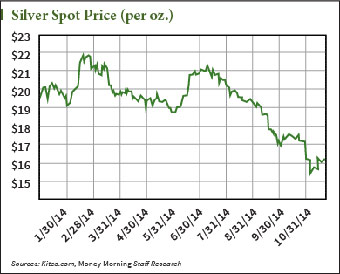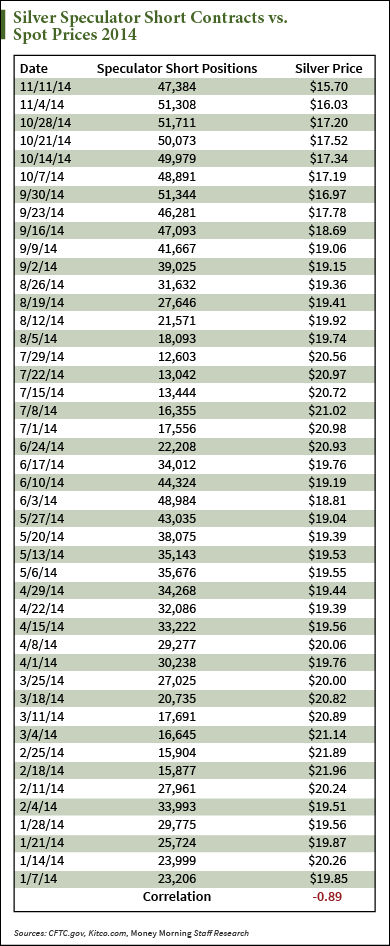Silver prices in 2014 have been pummeled in this second half. Just look at the accompanying silver price chart.
There are two main headwinds suppressing silver price gains right now. Each has a trigger point to watch for - a signal that this bearish period is about to reverse. That's when the price of silver will begin its rebound.
 Here's what they are so investors can prepare for silver market moves heading into 2015.
Here's what they are so investors can prepare for silver market moves heading into 2015.
Silver Price Headwinds in 2014: Bearish Speculation
The story with silver speculators has been the same throughout the year.
Speculators will take out short contracts on silver in droves, and that sell-side pressure will push prices down.
This has been the case the whole year. It was most obvious between February and June.
On Feb. 24, silver spot prices closed at their 2014 high of $21.965 an ounce. At this point, speculators held short about 79.5 million ounces of silver - a relatively low number.
At those high prices, speculators began mounting a larger short position each week.
 By June 2, when the silver price hit a then-2014 low of $18.76 an ounce, short sellers had built up a record high short position of 245 million ounces.
By June 2, when the silver price hit a then-2014 low of $18.76 an ounce, short sellers had built up a record high short position of 245 million ounces.
This pushed prices down, but then the same speculator activity reignited a silver rally. With short positions so high and prices so low, speculators wanted to capture profits. They bought long to cover their shorts.
By July 11, the massive short covering - when short sellers shed about 163 million ounces of silver in shorts - propelled silver prices up 14% to $21.445 an ounce.
The month-long short covering that boosted prices also brought short positions to lows not seen since February 2013. From there, the pattern started over and short positions mounted again.
That's where silver prices are now.
This time, they have been taken to even newer highs, almost 260 million ounces short by late October.
And prices began to fall below $16 for the first time in four years.
Short positions are still elevated as of the Commodity Futures Trading Commission's most recent reporting at about 237 million ounces
And while there hasn't been a consistent short covering session to propel prices up, the reality is, shorts can't be at this level for much longer before it does happen.
And that's when prices will see a jump.
Money Morning Members can see the next silver price headwind for free, in addition to the important trigger point that will indicate a bullish reversal of silver's current slide.
Silver Price Headwinds in 2014: Stronger U.S. Dollar
With the U.S. dollar topping off at seven-year highs, silver prices are taking a hit. Investors are not as interested in buying silver when the U.S. dollar value keeps climbing.
The reality is, the dollar can't stay this high forever.
It only looks good because currencies abroad are being devalued as central bankers look to bring on inflation.
Japan is readying for a more aggressive policy regimen of money printing. And the Eurozone, while it hasn't embarked on an easing policy, is getting closer. European Central Bank President Mario Draghi just today (Friday) made bold statements about a future ECB bond-buying program.
The expectation that both the euro and the yen will experience devaluation at the hands of inflationary monetary policy has speculators shorting both currencies.
But that's all that's buoying the current declines in the euro and the yen. It's all trader activity, not evidence that inflation is taking hold.
Japan and the Eurozone suffer from similar economic malaise. Both are trying to stave off deflation, a condition of low demand that is part and parcel to recessions, with policy prescriptions that don't work.
As long as the money pumped into the system sits on bank balance sheets, and consumers and businesses continue to pay down their debt, as opposed to taking on new debt, inflation will not take hold.
At some point, currency speculators won't see the kind of inflation they are hoping for, and they'll cover their shorts. This will hit the dollar, and boost silver.
Interested in Precious Metals? You Have to Read This. Love it or hate it, gold is not an optional investment - it's effective risk management for your portfolio. Money Morning Chief Investment Strategist Keith Fitz-Gerald provides you with a simple test to determine if you own enough gold, and a quick-and-dirty look at how to buy it.


